07.04.2006
S.Klimov. RATMIR KHOLMOV
Fischer - Kholmov
Capablanca Mem Havana (18), 1965
1.e4 e5 2.¤f3 ¤c6 3.Ґb5 a6 4.Ґa4 ¤f6 5.0-0 Ґe7 6.¦e1 b5 7.Ґb3 0-0 8.c3 d6 9.h3 ¤a5 10.Ґc2 c5 11.d4 Јc7 12.¤bd2 ¤c6 13.dxc5 dxc5 14.¤f1 Ґe6 15.¤e3 ¦ad8 16.Јe2 c4 17.¤g5 h6 18.¤xe6 fxe6 19.b4
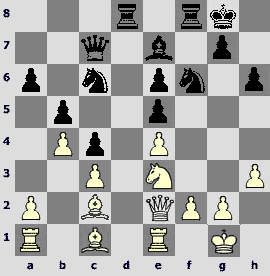
19...¤d4! 20.cxd4 exd4 21.a3 [21.e5 d3 22.exf6 Ґxf6 23.Јg4 Ґxa1 24.Јxe6+ Јf7 25.Јxf7+ ўxf7-+] 21...d3 22.Ґxd3 ¦xd3 23.¤g4 ўh7 24.e5 ¤xg4 25.Јe4+ g6 26.Јxg4 ¦f5µ
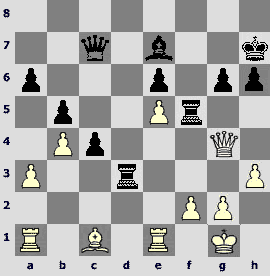
27.Јe4 Јd7 28.Ґe3 Јd5 29.Јxd5 ¦xd5! 30.f4 g5 31.g3 gxf4 32.gxf4 ¦f8 33.ўg2 ўg6 34.¦g1 ¦d3 35.ўf3+ ўf5!
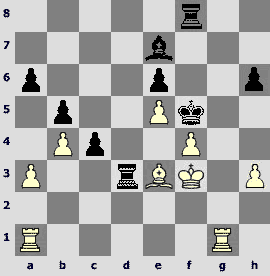
36.¦g7 Ґd8 37.¦b7 [37.¦ag1 ¦xe3+ 38.ўxe3 Ґb6+ 39.ўf3 Ґxg1 40.¦xg1 ¦d8-+] 37...¦g8 38.¦b8 ¦g7 39.a4 h5 40.axb5 axb5 41.¦xb5 Ґh4 42.ўe2 ¦g2+ 43.ўf1 ¦h2 44.ўg1 ¦e2 45.Ґb6 c3 46.ўf1 ¦h2
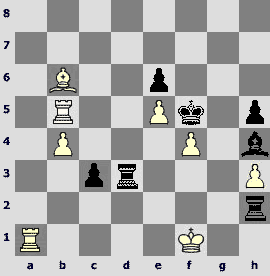
0-1
It's 40 days since one of the strongest Soviet chessplayers of the middle of the twentieth century Ratmir Dmitrievich Kholmov passed away.
Not to mention high sportive results, which would be sufficient for the leadership in the most European teams of his days, R.Kholmov showed a unique chess longevity – till the end of his days, even he had already been seventy years old, he kept playing strong..
However, those who watched only recent games of Kholmov can hardly appreciate his strength in his prime – from the late 50s till the beginning of the seventies. Almost all leading players of the middle of the previous century had a chance to experience it.
Kholmov - Spassky
Moscow zt (2), 1964
1.e4 c5 2.¤f3 e6 3.d4 cxd4 4.¤xd4 ¤f6 5.¤c3 d6 6.Ґe2 a6 7.0-0 Ґe7 8.Ґe3 Јc7 9.f4 0-0 A more cautious way of preventing the next move of White is 9...¤c6.
10.g4! A strategic tool which is very non-typical of the chess of the 60s – moving the pawns away from the king so early was a rare case at that time – though it became very popular in the early nineties.
10...¤c6 11.g5 ¤d7 12.f5 ¤de5 Black also has a dangerous position after 12...¤xd4 13.Јxd4 ¦e8 14.fxe6 fxe6 15.Ґh5, for example: 15...g6 (15...¦f8) 16.¤d5 exd5 17.Јxd5+ ўh8 18.Јf7 Јd8 19.Ґd4+ ¤e5 20.Ґxg6 hxg6 21.Јxg6 with White's devastating attack (L.Bruzon – M.Sadler, Istanbul, 2000)
13.f6 Ґd8 14.fxg7 Perhaps stronger is 14.Ґd3!?, as Sutovsky played in a game below.
14...¦e8?! As the further experience showed, here one must play 14...ўxg7, without weakening the f7-pawn. 15.Јd2 b5 16.Ґh5 ¤e7
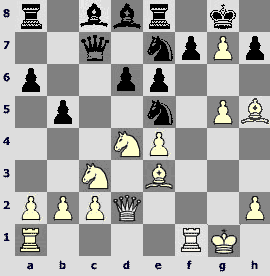
17.b3!І A move ... in Anand's manner! At least such a brilliant breadth of play is more typical of the Indian chessplayer than of any other.(Kholmov considered a sacrifice 17.¤dxb5 axb5 18.¤xb5 Јc6 19.¤xd6 Ґb7 leading to unclear play
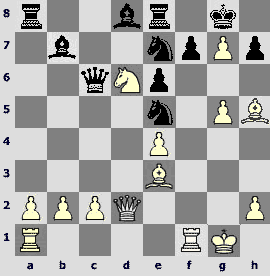
" everything was absolutely clear for me" (Kholmov). However, Black does not manage to incarnate his chances: 20.Јf2! ¤f5 (20...ўxg7 21.Јf6+ ўg8 22.¤xf7+- with a mate; 20...¤7g6 21.Ґxg6 hxg6 22.Јh4 – mating in a few moves матвнесколькоходов) 21.¤xb7 Јxe4 22.¤xd8 ¦exd8 23.Ґf4+- - the piece is regained, White has a lot of extra pawns. I can not attach a question mark to a refined positional decision of Kholmov, although the knight sacrifice on b5 was almost winning.)
17...¤7g6 18.a4! Black's pieces are indeed disposed badly on both sides and he won't endure a full-scale attack.
18...bxa4 [18...b4 19.¤ce2ѓ]
19.¦xa4 Ґb7 20.¤f3! Exchanging the main defender
20...Јe7 Did not solve Black's problems 20...¤xf3+ 21.¦xf3 ¤e5 22.¦f2 ўxg7 23.Ґf4 , and White takes the f7-pawn, because bad is (but not 23.Ґd4 ¦f8 24.¦c4 Јe7 , achieving a more advantageous for Black version of the game position) 23...¦f8 24.¦d4 Ґe7? 25.Ґxe5+ dxe5 26.¦d7+-
21.¤xe5 dxe5 (21...¤xe5 22.Ґf4 , the f-7 pawn "falls" again) 22.¦c4 ўxg7 (It seems that now Black had the last chance of loosing a bit: 22...a5!? …Ґa6)
23.¤a4 ўg8 24.Ґxg6 hxg6 25.Јc3! Ґd5!? A move in the manner of the famousо ¤b8-c6 in the game Averbakh - Spassky. The future world champion finds a possibility of continuing the struggle . (The e5-pawn could not be rescued anyway: 25...Јd6 26.Ґc5 Јb8 27.Јf3 Јc7 28.Ґd6! Јd7 (28...Јxd6 29.Јxf7+ ўh8 30.Јxe8++-) 29.Ґxe5±; 25...a5 26.¦f2 Ґa6 27.¦c5 Јd6 28.¦d2±)
26.exd5 exd5 27.¦c6! Јd7 (Tactics again – impossible is 27...d4 28.Јc4 dxe3 29.¦xg6+ ўf8 30.Јh4+-)
28.Ґf2! Ґa5 , and Kholmov missed a correct 29.¤b6!+- , keeping a piece, but he won the game in the throes after (29.¦xg6+? fxg6 30.Јxa5 ¦f8 31.¤c3±) 1-0
A game, which is a leap into the future! Please, compare:
Sutovsky – Polgar
Tilburg Fontys (7), 1996
1.e4 c5 2.¤f3 d6 3.d4 cxd4 4.¤xd4 ¤f6 5.¤c3 a6 6.Ґe2 e6 7.f4 Ґe7 8.Ґe3 0-0 9.0-0 Јc7

10.g4 ¤c6 11.g5 ¤d7 12.f5 ¤de5 13.f6 Ґd8 14.Ґd3 ¤xd4 15.Ґxd4 Јa5 16.fxg7 ўxg7
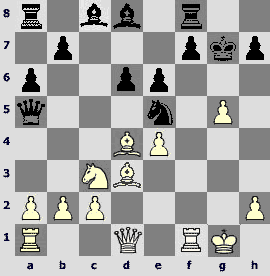
17.ўh1! Exchanging the strong e5-knight is a key to the position.
17...Ґb6 18.Ґxe5+ Јxe5 19.Јh5± Threatening to move one rook to f6, and another one to g1, check with the queen from h6 and play g6.
19...Ґe3 20.¦f3 Ґxg5 21.¦g1 f6 22.h4 1-0
In general Ratmir Kholmov was extremely dangerous in positions with initiative, his attacks were drastic and was not afraid of intuitive sacrifices. And even in the most difficult position his calculation was at the highest level.
Kholmov - Bronstein
URS-ch32 Kiev, 1964
This is one of the most famous games of Ratmir Kholmov.
1.e4 c5 2.¤f3 ¤f6 3.¤c3 d6 4.d4 cxd4 5.¤xd4 a6 6.Ґg5 e6 7.f4 Ґe7 8.Јf3 Јc7 9.0-0-0 ¤bd7 10.g4 b5 11.Ґxf6 gxf6 12.f5 ¤e5 13.Јh3 0-0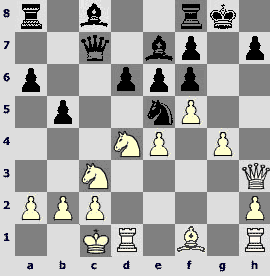
This a bit extreme defense method in such positions was first used by Fischer in a game against Gligoric in 1959.
14.g5!? Does not win and here comes another attempt to attack Black's position immediately: 14.Јh6 ўh8 15.g5 ¦g8 16.g6 fxg6 17.fxe6 Ґb7 18.¤d5 Ґxd5 19.exd5 f5! 20.Ґg2 Ґf6¥ - opposite-colored bishops are in favor of Black here. John Nunn in his book on 6.Ґg5 variation promises advantage to White after 14.¦g1 ўh8 15.¤ce2 (or 15.¦g3 first) 15...¦g8 16.¦g3 (16.¤f4 d5 17.fxe6 dxe4¥) 16...Ґd7 17.¤f4 ¦ac8 18.fxe6 fxe6 19.Јg2 ¤xg4 (хуже 19...Ґf8 20.¤fxe6± Brodsky - Stoica, Romania, 1994) 20.¤fxe6 Ґxe6 21.¤xe6 Јd7 22.¤d4 ¤e3 23.Јh3 Јxh3 24.Ґxh3 ¦xg3 25.hxg3 ¦g8 26.¦g1І
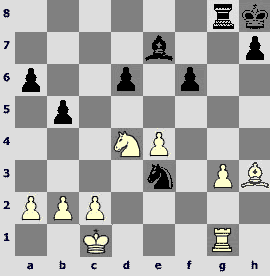
- a typical situation for this line: the capture on e6 destroys Black's pawn structure, but he still has some resources.
Speaking objectively, perhaps the continuation chosen by Kholmov is not the strongest one, but it requires a great precision from Black.
14...b4? (№14...fxg5 15.fxe6 fxe6 16.¤xe6 Јd7 17.¤d5, and now
A) More brisk is 17...¦f3!?
A1) 18.¤b6 ¦xh3 19.¤xd7 Ґxd7 20.Ґxh3 g4µ;
A2) 18.Јh6 Јxe6 19.Јxe6+ Ґxe6 20.¤c7 (20.¤xe7+ ўf7) 20...¦c8 21.¤xe6 g4;
A3) 18.Јh5 18...Јxe6 19.Јe8+ Ґf8 20.Јxe6+ Ґxe6 21.¤c7 ¦c8 22.¤xe6 g4
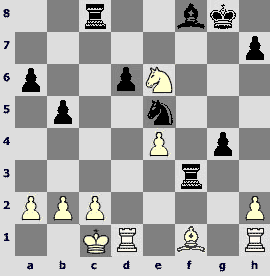
- I think that Black can play this position for a win;
B) 17...Јxe6 18.Јxe6+ Ґxe6 19.¤xe7+=; 14...ўh8, which was used in the game Rother - Guennewig, Recklinghausen 1999, is also playable, as it provides Black with an extra tempo during White's attack on the kingside.)
15.gxf6 Ґxf6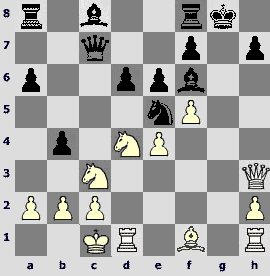
16.¦g1+ ўh8 17.Јh6 Јe7

Here comes one of the most beautiful thematic combinations
18.¤c6!! ¤xc6 19.e5!, vacating the e4-square for the knight and the b1-h7 diagonal for the bishop (19.¦d3 Ґg5+ 20.¦xg5 f6)
19...Ґg5+?! (19...Ґxe5 20.f6! Ґxf6 21.Ґd3 Ґg5+ 22.¦xg5, and now there are two ways of playing – Black can prevent mating with tempo by 22...f6 23.¦g3 (23.Ґxh7 fxg5 24.Ґe4+ ўg8 25.¦g1 ¦a7) 23...¦f7 (23...bxc3? 24.Ґxh7 with a mate – Kholmov's variation) 24.¦dg1 Јf8 (24...Ґb7 25.¤e2 ¤e5 26.¤f4 ¦c8 27.ўb1 – no Black's active moves are in the perspective.) 25.Јh4 f5 26.¤e2 ¦aa7 27.¤f4 ¤e5 28.¤h5; or
22...f5! 23.¦dg1! ¦a7 24.¤e2! ¤e5 (24...e5 25.Ґc4+-) 25.¤f4±

"and Black cannot prevent the knight's move to h5 and rook's invasion on c7". Let's have a more careful look: 25...¦e8 (to take the rook away from the queen's blow) (25...¦c7 26.Ґxf5±) 26.¤h5 ¤g4 27.¦1xg4 fxg4 28.Ґxh7! Јf8 29.¦g8+ Јxg8 30.Ґxg8+ ўxg8 31.¤f6+ with White's win; 19...¤xe5!? 20.¤e4 ¤g6! (20...¤d7 21.¦xd6+-) 21.¤xf6 Јxf6 22.fxg6 Јg7! 23.Јxg7+ ўxg7 24.gxf7+ ўxf7 25.¦xd6±

Kholmov wrote the following: "White stands better in the ending, but it's impossible to assert that it' won. Perhaps he will manage to win the h7-pawn, but because of the active disposition of Black's king, the situation is still not clear enough." It remains only to subscribe to this opinion. Here come sample variations: 25...a5!? (or 25...h6 26.¦d4 ¦b8 27.¦f4+ ўe8 28.¦xf8+ ўxf8 29.¦g6; 25...ўe7 26.¦d4 a5 27.¦h4 ¦f7 28.Ґd3 Ґa6 29.¦xh7 ¦xh7 30.Ґxh7) 26.Ґd3 ўe7 27.¦d4 h6 28.¦g6 ¦f6 29.¦g8)
20.¦xg5 f6 21.exd6 Јf7 22.¦g3 bxc3
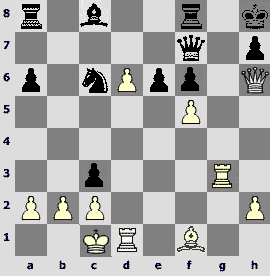
23.Ґc4!+- A brilliant indifference to the material. Black is almost stalemated, and there is no defense against the capture on e6 or d6-d7
23...cxb2+ 24.ўb1 ¤d8 24...¦g8 25.¦xg8+ Јxg8 26.d7 Ґxd7 27.¦xd7 Јg1+ 28.ўxb2 ¦b8+ 29.Ґb3+-; 24...¦e8 25.d7 Ґxd7 26.¦xd7 ¦e7 27.Ґxe6 Јf8 28.¦g8++-; 24...¦d8 25.fxe6 Јf8 26.e7 ¤xe7 27.Јxf8+ ¦xf8 28.dxe7 ¦e8 29.¦d8+-
25.¦dg1 (it's simpler to play 25.d7 Ґxd7 26.¦dg1 …¦g7+- at once)
25...¦a7 26.d7 ¦xd7 27.fxe6 ¤xe6 28.Ґxe6 ¦d1+™ 29.¦xd1 Ґxe6 30.ўxb2 ¦b8+ (30...Ґxa2 31.¦d7 ¦b8+ 32.ўa3!+-) 31.ўa1 Ґxa2 32.¦gd3+- Јe7 33.ўxa2 Јe6+ 34.¦b3 Apart from the victory I'd like to mention an excellent quality and objectivity of Kholmov's comments of this game. 1-0
Kholmov - Bannik
URS-ch30 Yerevan (16), 14.12.1962
1.d4 f5 2.c4 ¤f6 3.¤f3 g6 4.g3 Ґg7 5.Ґg2 0-0 6.0-0 d6 7.¤c3 c6 8.¦e1 ¤e4 9.Јd3 ¤xc3 10.bxc3 e5 11.e4 Јa5 12.Ґg5 ¦e8
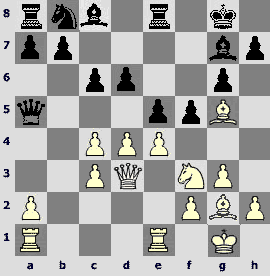
Perhaps 12...d5 recommended by Kholmov is better followed by 13.cxd5 fxe4 (13...cxd5 14.¤xe5 fxe4 15.Јe3 ¤c6 also deserves attention) 14.Јxe4 cxd5 15.Јh4 e4 16.Ґh6!? Ґf6 17.¤g5.
Trying to use Black's kingside underdevelopment, Kholmov undertakes a sacrifice, which is both calculative and intuitive.
13.¤h4!? f4 A continuation that is almost essential in this position and natural for a Dutch structure. The g5-bishop escape routes are cut off.
14.gxf4 h6 15.Ґxh6 Ґxh6 16.Јg3 Ґg7 17.Јxg6 ¦f8 Perhaps it was stronger to play 17...Јd8 , which allows Black to complete the queenside development : 18.¤f5 (18.fxe5 dxe5 19.¤f3 ¤d7 20.¦ad1 Јe7 21.¤g5 ¤f8; 18.¦e3 exf4µ) 18...Ґxf5 19.exf5 ¤d7 – a move which Black did not manage to make in the game.
18.¤f5! In the notes to this game Kholmov explains that he rejected 18.fxe5 dxe5 19.¤f5 because of 19...Ґxf5 20.exf5 ¤d7.
18...Ґxf5 19.exf5 e4!
Playing 19...¤d7 is not a good idea here as White captures the d-6 pawn, which is still on board and also the e5-pawn afterwards.
20.f6! ¦xf6 21.Јe8+ ¦f8 Bad is 21...ўh7 22.Ґxe4+ ўh6 23.¦e3 Јh5 24.Јg8 ¦g6+ 25.¦g3+-; However, it seems that it was worth undertaking an extremely dangerous at first sight 21...Ґf8 22.¦e3
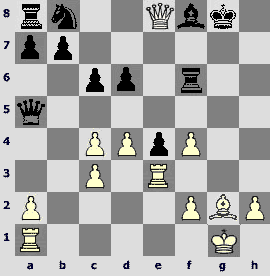
And though Kholmov considers that White wins immediately here, Black could keep resisting. 22...Јc7!? 23.¦g3+ ўh8 24.¦h3+ ўg8 25.ўh1 , and here comes 25...Јf7 , cutting off White's queen escape routes to the kingside 26.Јd8 (26.Јxe4 ¦xf4) 26...Јe7 , exchanging the queens;
In any way, White had a chance of making a mistake in the variation 21...Ґf8. Now everything is simple.
22.Јe6+ ¦f7 23.Ґxe4!+- ¤a6 24.Ґg6 ¦af8 25.Јh3! Ґf6 26.Ґxf7+ ¦xf7 (26...ўxf7 27.Јh7+ Ґg7 28.¦e7+ ўxe7 29.Јxg7+ with a win) 27.¦e8+ ўg7
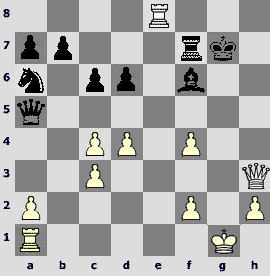
28.ўh1 It is a usual thing that bringing the second rook into attack is decisive.
28...¦e7 29.Јh8+ ўg6 30.¦g1+ Black resigned. 1-0
Ratmir Kholmov had firm and longstanding chess preferences. For instance, he was not fond of playing positions like the King's Indian, in which Black has lots of positional weaknesses and can trust only in Gufeld bishop. He liked exchanging the c6-knight for the light-squared bishop in the Sicilian defense and generally playing strategically simple positions.
Kholmov - Keres
URS-ch26 Tbilisi (17), 1959
1.e4 c5 2.¤f3 ¤c6 3.Ґb5 ¤f6 4.e5 ¤g4 5.Ґxc6 dxc6 6.0-0 g6 7.¦e1 Ґg7 8.h3 ¤h6 9.¤c3 b6
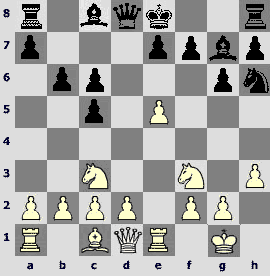
Simpler is 9...0-0 10.d3 (weakens White's position severely 10.g4 f5 11.g5 ¤f7) 10...¤f5.
10.d4! cxd4 11.¤xd4 c5
One should play 11...Ґb7 12.Ґxh6 Ґxh6 13.Јg4 0-0 (13...c5 14.¤f3 0-0 15.¦ad1 Јc8 16.¤d5 Ґxd5 17.Јxc8 ¦fxc8 18.¦xd5 ¦d8 19.¦ed1 ¦xd5 20.¦xd5 ўf8 21.¦d7 ўe8 22.¦b7) 14.¦ad1, and now the computer suggests 14...Јc8 , since after 15.Јh4 Ґg7 the capture on e7 is not decisive: 16.Јxe7 ¦e8. Now 17.Јd6 wins: 17...¦d8 (17...c5 18.¤db5 ¦d8 19.Јe7 ¦e8 20.Јc7. If Black plays 14...Јc7, then 15.¤f5 Ґg7 16.¦d7!+-. Finally, 14...Јe8 is met by 15.¤f5 Ґg7 16.¤xg7 ўxg7 17.¤e4ѓ.
12.¤c6! An unexpected resource.
12...Јd7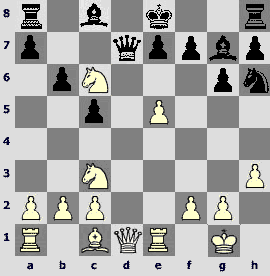
The ruse lies in the fact that bad is 12...Јxd1 13.¦xd1 Ґb7 14.¤b5 , and it's impossible to capture on c6: 14...Ґxc6 15.¤c7+ ўf8 16.¤xa8 Ґxa8 17.¦d8#.
13.¤xe7! ўxe7 13...Јxd1 14.¦xd1 ўxe7 15.Ґg5+ (15.¤d5+!?) 15...ўe6 16.¦d6+ ўf5 (16...ўxe5 17.¦d5+ ўe6 18.¦e1+ with a mate) 17.f4 Ґxe5 18.¦d5 f6 19.Ґxh6 Ґb7 20.fxe5 Ґxd5 21.¤xd5 ўxe5 22.c4 – Black's position is hopeless. Relatively better is 13...Јxe7, which leads to a bad for Black position after 14.¤d5 Јd8 15.¤f6+ Ґxf6 (15...ўe7 16.Ґg5 Јxd1 17.¦axd1 Ґf5 18.¤h5+ ўf8 19.¤xg7 ўxg7 20.Ґf6+ ўg8 21.¦e2+-) 16.exf6+ Ґe6 17.Ґxh6 Јxf6
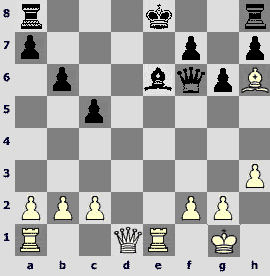
18.c3 – neither castling is possible, there is only 18...g5 19.Јh5 (or 19.Јd5 ¦d8 20.Јxg5 Јxg5 21.Ґxg5; 19.Јa4+ ўe7) 19...Јg6 20.Јxg6 (or 20.Јxg5 Јxg5 21.Ґxg5 ¦g8 22.h4 ўd7) 20...hxg6 21.Ґxg5 ўd7 – Black is a pawn down , but opposite-colored bishops always leave a chance for the defender. In any case, a fact that Black manages to pay off by a pawn is a great achievement for him.
14.Ґxh6! Ґxh6 15.Јf3! Ґg7 15...¦e8 lost immediately because of the variation 16.¦ad1 Јb7 17.Јf6+ ўf8 18.Јh8+ ўe7 19.¤d5+ Јxd5 20.Јf6+.
16.¤d5+!(rejecting a capture on a8) 16...ўd8 (16...ўe8 17.¤f6+ Ґxf6 18.exf6++-)
17.¦ad1
It's visibly clear that such a position can't be held.
17...Ґb7 In response to17...Јb7, 18.e6!! is decisive: 18...fxe6 19.¤b4+ ўc7, and there is 20.Јg3+ e5 21.¦xe5.
18.Јb3+- Ґc6 19.¤xb6 axb6 20.Јxf7 Ґxe5 21.¦xd7+ Ґxd7 22.¦xe5+- ўc7 23.¦e7 ¦ad8 24.a4 g5 25.Јd5 ¦he8 26.¦xh7 g4 27.a5 gxh3 28.axb6+ ўxb6 29.¦xd7 The most remarkable thing about this game is even not depth of Kholmov's calculation (and the main variation had to be calculated as early as prior to playing d2-d4), but a brilliant idea ¤d4-c6xe7. Generally speaking this crushing win reminds of the best games of Kasparov.1-0
Kholmov readily undertook all endgames, almost never he was afraid of exchanges, pressing with White and patiently defending with Black in a bit worse positions. Due to the latter feature Kholmov had played almost a record number of endings, especially rook and knight ones.
Kholmov - Suetin
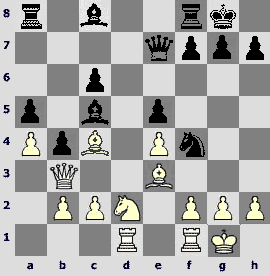
Black's queenside is a bit weak, but it seems that it's possible to hold. However ...
18.Ґxc5 Јxc5 19.Јe3! Јe7 After 19...Јxe3 20.fxe3 ¤e6 21.¤f3 Ґa6 (21...f6 22.¦d6 ¦e8 23.¦xc6±) 22.Ґxa6 ¦xa6 23.¤xe5 ¤c5 24.¤d7± Black stand simply bad.
20.¤b3 Now it seems that the next move of Black is forced, otherwise White will get on c5 or b6.
20...Ґe6 Here was an absolutely unexpected resource 20...Ґg4! 21.¦d2 (21.f3 Ґh3! 22.¦f2 Јg5 23.g3 Ґe6! with advantage to Black) 21...Јg5 22.Јg3 (22.g3 ¤h3+ 23.ўg2 Јxe3 24.fxe3 ¤g5µ) 22...¤h5 23.Јe3, and Black can decide between a draw, repetition of moves and 23...Јxe3 24.fxe3 ¤f6.
21.Ґxe6 ¤xe6 22.¦d2 c5 Better is 22...¦fd8 23.¦fd1 ¦xd2 24.¦xd2 ¦d8 25.¦xd8+ Јxd8 26.Јd3 Јc7 27.h3 (27.Јa6 Јd7; 27.g3 h6 28.Јa6 Јd7) 27...h6, and if 28.Јa6, then in any case28...Јd6 with counterplay. Taking into consideration the events that followed, it would be more pleasant for Black to play a position without rooks.
23.¦d5 c4 24.¤c5 ¦fc8 24...¤f4 25.¦d7 Јg5 26.g3±.
25.¤xe6 Јxe6 26.¦fd1± White controls the only open file and playing Black is extremely unpleasant.
26...Јc6 (26...Јe7 27.Јb6!)
27.¦b5 c3?! Allows White defending a vulnerable a4-pawn. It was better to play 27...¦d8 28.¦xd8+ ¦xd8 29.h3.
28.b3 ¦d8 29.¦bd5 Now after 29.¦xd8+?! ¦xd8 30.h3 h6 31.¦xa5 ¦d2„ Black uses a square for the rook that was obtained by the 27th move.
29...¦xd5 (29...Јc7? 30.Јa7!+-) 30.¦xd5 Јf6 31.g3 h6 32.Јd3 ўh7 33.h4 Јe6 34.ўg2 f6 35.¦d6 Јf7 36.Јf3 h5 37.Јd3 ¦a7 38.¦d8 Јg6 39.Јd5 Јf7 40.Јd3?
According to Kholmov, 40.Јxf7! wins: 40...¦xf7 41.¦d5 ¦a7 42.f4! exf4 43.¦xh5+ ўg6 44.g4! ¦d7 45.¦d5+- ¦xd5 46.exd5.
40...Јe6 41.Јd1 Јf7 42.Јd6 ўg6!? 43.f4!? exf4 44.gxf4 ўh7 45.ўf2! ¦e7 45...Јg6 46.Јe6 ¦f7 47.Јe8+-.
46.ўf3! Now the queen does not get to g6 – the rook is hanging.
46...f5 47.e5 ¦e6 48.Јb8! ўg6 49.Јa8 Јe7 50.Јc8 ¦b6 51.¦f8 ¦e6 There won't be many volunteers to play the ending after 51...Јb7+ 52.Јxb7 ¦xb7 53.¦d8 ўf7±, despite having heavy pieces Black simply gets mated.
52.ўg2 ўh7 53.ўh3 ўg6 54.¦h8! (…Јg8) 54...Јf7 55.Јd8! ¦e7 56.Јd1!+- - Black gets mated. An excellent example of converting positional advantage with heavy pieces. As for Black's resistance, he just missed the opportunities of answering with a snarl in the very beginning. 1-0
The 18th move of White reminds of the game
Botvinnik - Sorokin
URS-ch07 Moscow, 1931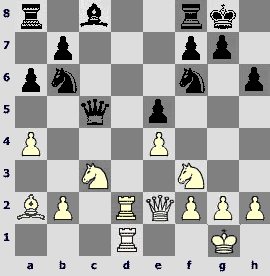
20.Јe3! Јxe3 21.fxe3 Ґg4 22.a5 ¤c8 23.¦c1 Ґxf3 24.gxf3 ¤e7 25.¤d5 ¤c6 26.¤xf6+ gxf6 27.¦d7 ¦ab8 28.ўf2±

28...¤xa5 29.¦cc7 ¦bc8 30.¦xf7 ¦xc7 31.¦xc7+ ўh8 32.Ґd5 b5 33.b3 ¦d8 34.ўg3 f5 35.ўh4 fxe4 36.fxe4 ¦d6 37.ўh5 ¦f6 38.h3 ¦d6 39.h4 ¦b6 40.ўg4 ¦f6 41.¦a7 ¦b6 42.¦e7 ¦d6 43.¦c7 ¦f6 44.¦a7 ¦b6 45.¦c7 ¦f6 46.ўh5 ¦d6 47.Ґf7 ¦f6 48.Ґg6 ¤xb3 49.ўxh6 ¦f8 50.¦h7+ ўg8 51.¦g7+ ўh8 52.Ґf7 ¦xf7 53.¦xf7 ўg8 54.ўg6 ¤d2 55.¦d7 1-0
Kholmov - Filip
Chigorin mem Sochi (6), 1973
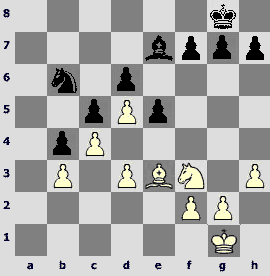
One of the positions that are objectively drawish almost for sure, but it's extremely difficult for the defending party to set up an arrangement.
30.g4 f6 Sergey Dolmatov suggests 30...g6!? 31.¤d2 (perhaps Black wanted to prevent 31.g5 ) 31...f5 32.gxf5 gxf5 33.f4 ўf7 34.ўg2 ¤d7 35.fxe5 dxe5= , but Black prefers passive behavior.
31.¤d2 ўf7 32.f4 ¤d7 33.fxe5 fxe5 And again it would be better to upset the symmetry - 33...dxe5!? 34.ўf2 g6 35.¤e4 f5.
34.¤e4 h6 A pawn gets on a dark square.
35.ўg2 ¤f6 36.¤g3 ¤g8 37.ўf3 g6 38.¤e4 Ґf8 39.g5 hxg5 39...h5 is suddenly met by 40.d4! exd4 (40...cxd4 41.Ґd2+-) 41.Ґf4+- , collecting the queenside pawns.
40.Ґxg5 ўe8 41.ўg4 ўd7 42.h4 ўe8 43.h5 gxh5+ 44.ўxh5 ўf7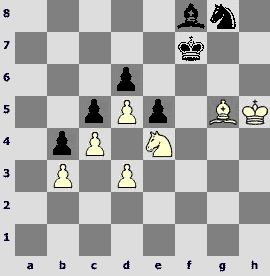
45.Ґh4 ўg7 46.Ґd8 ўf7 [(46...¤h6 47.Ґf6+ (47.Ґc7 ¤f7 48.Ґb8 Ґe7) 47...ўf7 48.ўg5 ¤g8 49.Ґd8) 47.ўg5 ўe8 48.Ґc7 ўd7 49.Ґb8 ¤h6 50.¤f6+ ўc8 51.¤h7 (51.Ґxd6? ¤f7+-+) 51...ўxb8
51...e4 loses by force: 52.dxe4 ўxb8 53.¤xf8 ¤f7+ 54.ўf6 ¤e5 55.ўe7 ¤xc4 56.bxc4! b3 57.e5 b2 58.exd6 b1Ј 59.d7 Јe4+ 60.¤e6 Јh7+ 61.ўd6+- (Dolmatov).
52.¤xf8 e4 (52...¤g8 53.¤e6 ўc8 (53...ўb7 54.¤g7 ¤e7 55.¤f5 ¤c8 56.ўf6+-) 54.¤g7 ўd7 55.¤f5+-) 53.¤d7+!
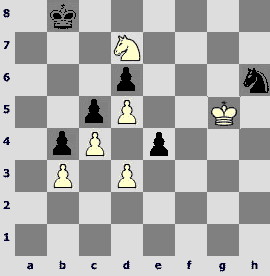
Afterthecaptureone4 theknight can't get on e5 – Black resigned 1-0
Since late 50s-early 60s Kholmov was nicknamed a "central defender". (I do not presume to tell who exactly had nicknamed Ratmir Kholmov, however in the "Chess yearbook" of 1961, for example, this nickname was already widely used). And Kholmov deserved this name as the grandmaster often contrived to defend worse and bad positions against chessplayers of any strength as he had unbelievably strong nerves and enormous stubbornness. Here come a few examples.
Petrosian - Kholmov
URS-ch24 Moscow (10), 1957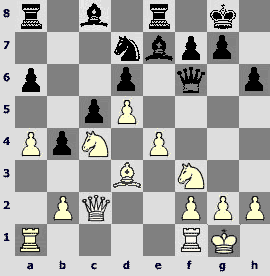
The position cries out to be in the positional play manual: here is a textbook knight on c4, and here is a bad bishop of Black on e7, which has no normal moves, and here comes White's plan – threatening with f2-f4, which Black can prevent by g7-g5, which will also weaken the f5-square. If Petrosian had played against any average master or even western grandmaster, this encounter would have had chances to enrich his selected games, However, let's have a look at further events:
15.¤fd2 g5 16.¦fe1 Ґf8 17.¦ad1 ¦a7 18.a5 A crucial move – it's certainly desirable to get the b6-square under control, and it's a good thing to fix the a6-pawn, but now the rook has to defend the a5-pawn. 18...Јd8

19.e5 A breakthrough in the center according to classical canons of chess art – there should be a breakthrough somewhere in order to use the weakness of light squares.
19...¤xe5 20.¤xe5 ¦xe5 21.¦xe5 dxe5 22.¤c4 Јf6 23.Јe2 Ґd6 24.b3 ўf8 25.¤b6 Јd8 26.Јf3 Ґd7 Hinting at Ґd7-b5.
27.¤xd7+ ¦xd7 28.Јh3
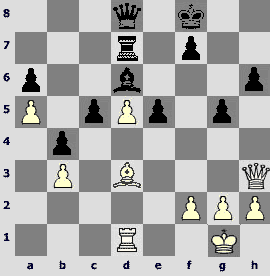
28.Јf5!?
28...h5!? (Actually there was nothing terrible in 28...ўg7 , because there is no sense for the queen of White to visit Black: 29.Јf5 ўf8 30.Јh7 Јf6 , but Kholmov gives up an extra pawn trying to play for a win. Judging from the next steps of White, it's clear that he had serious time problems.) 29.Јxh5 Јf6 30.Ґxa6 (30.Јh3!?) 30...¦a7 31.Ґd3 ¦xa5 32.Јe2 ¦a3 33.Јc2 ўg7 34.Ґc4 ¦a8 35.h3 ¦h8
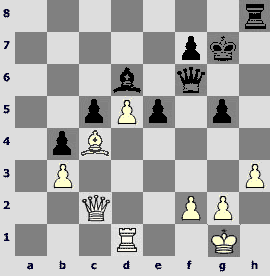
Trying to enter White's camp from another side along the open h-file.
36.¦e1 The first step to disaster. White wants to exchange a rook for four files at once, but misses a tactical blow 36...g4! and collapses.
37.hxg4 (37.¦e3 still let having a draw) 37...Јh4 38.Јe4 (One should play 38.ўf1 Јxg4 39.ўg1 Јh4 40.ўf1 Јh1+ 41.ўe2 Јxg2µ)
38...Јh1# A mate on board. By the way, impregnable Tigran Petrosian Sr. was defeated as White by Ratmir Kholmov three times.0-1
Spassky - Kholmov
URS-ch29 Baku (6), 25.11.1961
Having played the Schliemann gambit (which Kholmov constantly used in that USSR championship) Black was remained a pawn down, having got an opportunity of... making a hundred-move draw as a compensation. Andhemanagedtodoit!
18.Јf3 ¦he8 19.¤e4 Јd4 20.¤xf6 ¦xe3 21.fxe3 Јxf6 22.ўf2 ўe6 23.Јxf6+ gxf6 24.ўe1
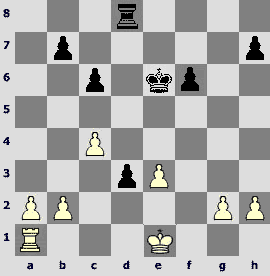
24...¦g8™ 25.g3 ¦g5 26.¦d1 ¦h5 27.h4 ¦f5 28.¦xd3 ¦f3 29.g4 ¦h3 30.h5 ¦g3 31.¦b3 (everything is forced yet) 31...¦xg4 32.¦xb7 ¦xc4
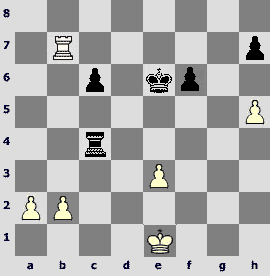
33.¦xh7 In a tournament game collection it was suggested to play 33.ўd2 , after which Black would have to play 33...h6 (in comparison with the variation 33...¦h4 34.¦xh7 ¦h2+ 35.ўc3 ¦e2 ensnaring the rook to a worse position) 34.¦h7 ¦h4 35.¦xh6 ¦h2+ 36.ўc3 ¦e2 37.a4 (more precise is 37.¦h8 , since after 37...¦xe3+ 38.ўd4 Black can not attack the b2-pawn because of the check on e8) 37...¦xe3+ 38.ўd4 ¦b3 39.ўc5 ¦xb2 40.ўxc6 , and White has a good chances to win here because he threatens with exchange of h- and f- pawns, having cut off the way to the f-file for the king of Black. However there are chances for a draw: 40...¦a2 (40...ўf7 41.¦h7+) 41.ўb5 ¦b2+ (41...ўe5 42.¦h8 f5 43.h6 ¦h2 44.h7 ўf4 45.a5+-) 42.ўc4 ¦a2 43.ўb3 ¦a1 44.¦h8 ўf7 (44...f5 45.h6 ўf7 46.h7 ўg7 47.¦f8+-).
A) 45.h6 ўg6 46.h7
A1) 46...¦b1+ 47.ўc4 (47.ўa2 ¦h1 48.a5? ¦h5=) 47...¦c1+ 48.ўb5 ¦b1+ 49.ўa6 ¦h1 50.a5 ўg7 51.¦c8 ўxh7=;
A2) 46...ўg7 47.¦f8+-;
B) 45.¦h7+ 45...ўe6 46.h6 ¦h1 (46...f5 47.¦h8+-) 47.a5 ўf5 48.a6 ўg6 49.¦b7 ўxh6 50.ўb2 ¦h5 51.¦b3 ¦a5 52.¦a3 ¦b5+ 53.ўc3 ¦b8 54.ўd4 ўg5 55.ўc5 f5=)
Spassky wants to get a position with a- and h- passed pawns in the presence of other pawns on board.
33...¦c2 34.h6 ¦xb2 35.¦a7 ¦h2 36.h7 c5 37.a4 ўd5
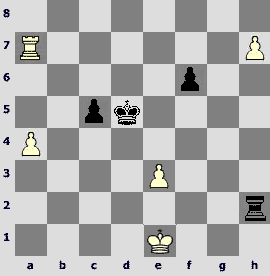
38.¦f7 Later it was fixed that 38.¦c7 is supposed to win, but there are still some unclear moments:
A) 38...ўd6 39.¦f7 c4 40.a5 c3 41.ўd1 (41.a6 c2, and Black wins!) 41...ўe6 42.¦c7;
B) 38...c4 39.a5 ўd6 (39...c3 40.a6 c2 41.a7+- , and a8Јthreatens with a check) 40.¦xc4 (40.¦c8 ¦xh7 41.¦xc4 ¦h1+=) 40...¦xh7 41.¦a4 ўc5 42.ўf2 (42.a6? ¦a7 43.ўf2 ўb5 44.¦a1 ¦xa6 45.¦xa6 ўxa6 46.ўf3 ўb5 47.ўf4 ўc4 48.ўf5 ўd3=) 42...ўb5 43.¦f4 (43.¦a1 ¦a7 44.ўf3 ¦xa5 45.¦xa5+ ўxa5 46.ўe4 ўb4 47.ўf5 ўc4=) 43...ўxa5 44.¦xf6 ўb5 45.¦d6 ўc5 46.¦d8 ¦e7 – it looks like a draw as the pawn of White is too far away from the promotion square).
One shouldn't forget that the time control has not been passed yet.
38...c4 39.a5 39.¦c7 c3 40.a5 (40.ўd1 ўd6 41.¦xc3 ¦xh7 42.¦a3 ўc5 with a draw) 40...c2 41.¦xc2 ¦xh7 42.ўd2 (White does not have enough time to place the rook behind the passer) 42...¦h1 with a draw.
39...c3 40.ўd1 (40.a6 c2 41.¦c7 ¦xh7=) 40...ўc4 41.a6 c2+ 42.ўc1 ўb3 43.¦b7+ ўc3 44.¦c7+ ўb3 45.a7 ¦h1+ 46.ўd2 ¦d1+ 47.ўe2 ¦d8
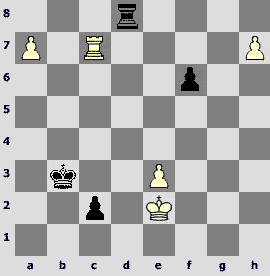
It turns out that Black has time to make a draw!
48.e4 In much the same way is 48.¦b7+ ўc3 49.¦b8 c1Ј 50.¦xd8 Јc2+ with a perpetual check)
48...ўb2 49.¦b7+ ўc3 50.¦b8 c1Ј 51.¦xd8 Јh1 52.¦c8+ ўb3 A draw by the perpetual after the queen promotion as in response to ўd4 Black can play Јe5+. 1/2-1/2
Kholmov managed to play in the most top tournaments with minimum of defeats in his best years. It was a difficult task to win a game against him even in his old age.
Bareev - Kholmov
Sochi, 1988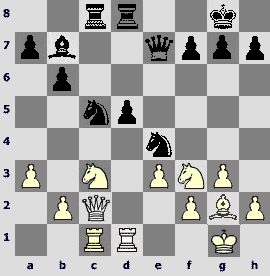
Only a chessplayer who can confidently make a draw as Black would voluntarily go for such a position. Peter Leko is a modern top player who is able to do this with confidence.
19.b4 ¤xc3 20.Јxc3 ¤e4 21.Јb2 g6 22.¤d4 Јe5 23.¦xc8 ¦xc8 24.¦c1 h5 25.¦c2 Ґa6 26.Ґh3 ¦xc2 27.Јxc2 Ґc4
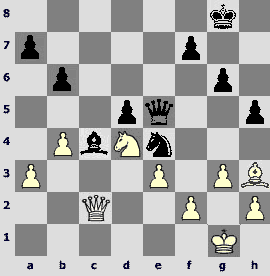
Sometimes even this bad bishop can be of use! It's not that Black has equalized, but he minimized the danger of a loss.
28.Ґg2 ¤d6 29.h4 ¤b5 30.¤xb5 Ґxb5 31.Јc8+ ўg7 32.Јb7 d4 33.exd4 One would possibly have no desire to go for position after 33.Јxa7 dxe3 34.fxe3 Јxg3 35.Јxb6 Јe1+ 36.ўh2 Јxh4+ taking into consideration a fact that White was playing for a win, but perhaps it's a necessary thing to do.
33...Јe1+ 34.ўh2 Јxf2 35.ўh3 It was possible to return with the queen 35.Јe4, but after 35...Ґf1 there arose a pone ending with an isolated central pawn of White 36.Јf3 Јxg2+ 37.Јxg2 Ґxg2 38.ўxg2
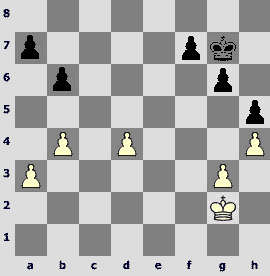
White stands bad: 38...ўf6 39.ўf3 ўe6 (39...b5 40.ўf4 ўe6 41.ўg5+-) 40.ўe4 b5 41.ўf4 (41.d5+ ўd6-+) 41...ўd5 42.ўe3 f6 43.ўd3 g5 44.ўe3 g4! 45.ўd3 f5 46.ўe3 ўc4 47.ўf4 ўxd4 48.ўxf5 ўe3 49.ўg5 ўf3-+.
35...Јg1-+, and now White's position became hopeless.36.Јe4 Ґd7+ 37.g4 Јf2 38.Јe5+ ўh7 39.ўh2 Ґxg4 40.ўh1 Јxh4+ 41.ўg1 Ґd7 42.d5 Јg4 0-1
Besides tenacity and stubbornness there were a few other reasons of such impregnability. Firstly, this is a classical style – bluff and gambling for a win that did not correspond with the position can rarely be found in Kholmov's games. Quite the contrary, he was remarkable for his rare objectivity of evaluation. Secondly, an excellent tactic sight, which allowed him punishing his opponents for "going too far".
Kholmov – Tolush
URS-ch24 Moscow (18), 1957
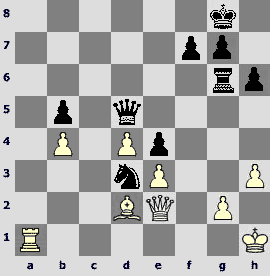
Black stands much better, he actually needs just to calculate and decide the game at proper time by attacking over open sights.
So, 26...ўh7 27.¦a7 ¦c6 28.ўg1 ¦g6 Black decided not to send the rook in the opponent's camp: in response to 28...¦c2 he, perhaps did not like 29.Јd1 ¦b2 30.Ґc3, and the rook seems to be driven from the second rank:
A) however stronger is 30...¤f2 31.Јf1 (31.Јe1 ¤xh3+! 32.ўh2 ¦f2 33.ўxh3 Јh5+ 34.ўg3 ¦e2 35.Јf1 ¦xe3+-+) 31...¦c2 32.Ґe1 ¤d3;
B) 30...¦f2 31.Ґe1.
So it seems that after 30...¤f2 Black is about to win. Maybe white would have to give the queen for rook and knight.
29.Ґe1 f5 30.Ґd2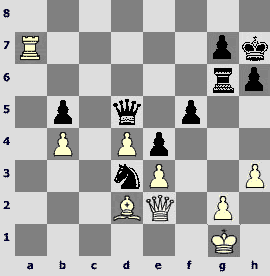
And finally Black moves forward: 30...f4 31.exf4 e3 32.Ґxe3 Јe4
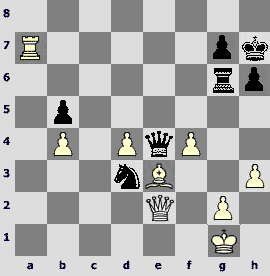
There is a threat of capture on f4 or ¦g3.
33.f5 ¦g3

34.f6! ¦xe3 (An unexpected trouble: 34...Јxe3+ 35.Јxe3 ¦xe3 36.¦e7!
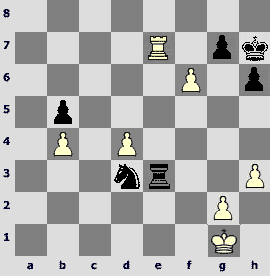
And either the pawn passes or Black simply gives the rook away.) 35.¦xg7+ ўh8

36.Јa2! Here comes the next trouble. Black is threatened with no less than a mate (even the possibility of which was a hardly believable thing before a tactical operation of Black).
36...¦e1+ 37.ўh2 Јf4+ 38.g3 Јf2+ 39.Јxf2 ¤xf2 40.¦e7 ¦d1 Leads to resignation, it would be more correct to play 40...¤d3 41.d5 ўg8, with the threat of capturing on e7 and keeping chances for a draw.
41.¦e8+ ўh7 42.f7 ¦d2 43.f8Ј 1-0
Kholmov was a really remarkable tactician, who calculated deeply and rarely lost an opportunity of delivering a sudden blow.
Uhlmann - Kholmov
Moscow CCCT (2), 1960
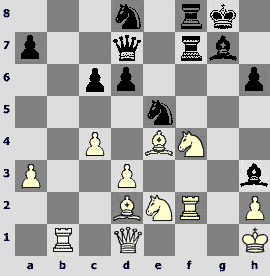
23...d5! 24.cxd5 cxd5 25.Ґxd5 Јxd5+ 26.¤xd5 ¦xf2 27.Ґf4 ¤f3
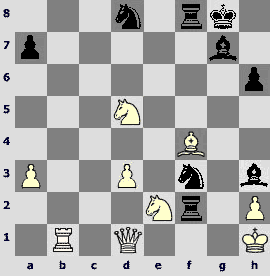
0-1
Matulovic - Kholmov
Kislovodsk 2/276, 1966
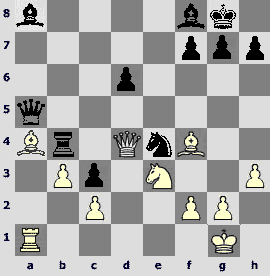
In the previous struggle White remained with a bad bishop on a4 and now takes measures to free it.
26.¤c4 26.Јd3 ¤c5 27.Јxc3 ¤xa4 28.Јe1! (28.bxa4 ¦b1+-+).
26...Јf5 27.Ґd7 Јxf4 28.¦xa8 ¦xb3!! 29.cxb3 c2 30.¦a1 c1Ј+ 31.¦xc1 Јxc1+ 32.ўh2 d5!-+ White has missed this. Either the queen destructs from defense of the f2-pawn or the Ґd should be tolerated.
33.Јxd5 (33.¤e5 Ґd6 34.g3 Јc2 35.¤d3 ¤xg3 is bad for White) 33...Јf4+ 34.ўg1 Јxf2+ 35.ўh2 Јf4+ 36.ўh1 ¤g3+ 37.ўg1 ¤e2+ 38.ўh1 Јf1+, mate next move.0-1
In comparison with other leading chessplayers of the post-war generation Ratmir Kholmov's sportive results were less impressive. He won the championships of many different republics of the Soviet Union, tied for the first place in the USSR championship, but did not manage to become a national champion, he didn't participate in the international tournaments, which were carried out abroad the socialist countries, finally he had never qualified for the candidates matches and tournaments. Perhaps there were also some objective reasons for that as well – maybe he worked less than the others on the opening, or played in too classical style and did not allow his "tactical" talent to function properly.
And a few words in conclusion. People play chess for different reasons – because of passion for playing, sportive ambitions, simply because of interest or just to "feel the taste of victory" as it is said in a well known slogan. Frankly speaking, besides the reasons mentioned above there has always been another one for me, which can be called a "living history". There is something special in the feeling when you can meet over the board with the people about whom you read in books as a kid. And another, even more amazing thing is that despite there have passed a few generations since the beginning of the previous century, you can still meet people who had played against the second world champion, and Kholmov really played against him. Figuratively speaking, playing with such a person is like meeting a hero of your favorite book in real life. .
There hardly can be found any other kind of sport which will make possible such an experience. In other sports the sportsmen's lifetime is so short that generations change occurs every ten years and only recollections remain about those who lived in the beginning of the previous century.
It's great that one can play chess, maybe less strong, even at the age of eighty.
And it's such a pity when such people leave us.
